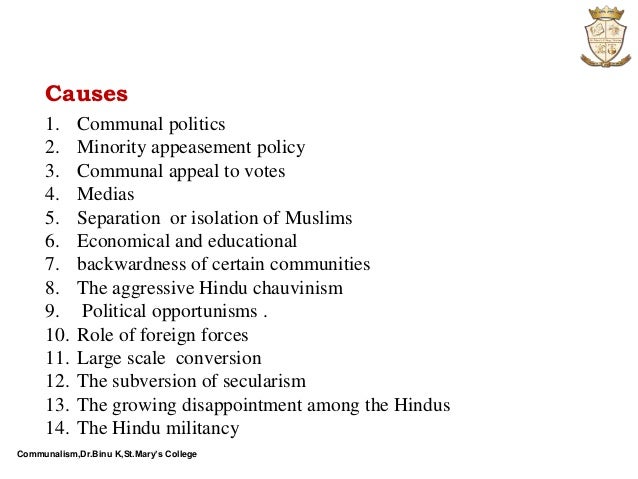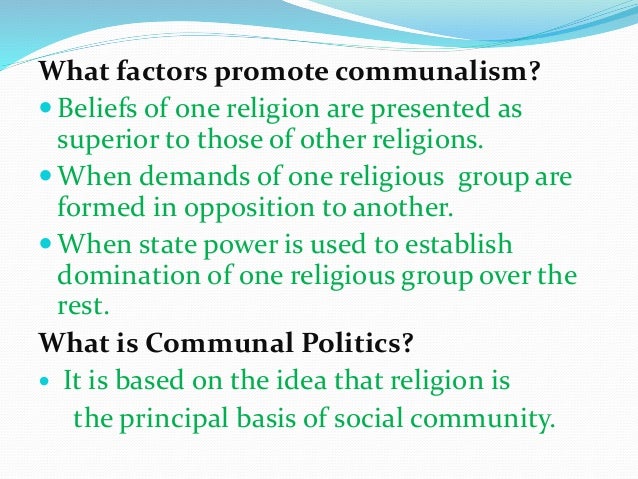COMMUNALISM
Relevance: Sociology:
Ethnic conflicts, communalism, religious revivalism.
G.S: paper I: Society: Diversity in India
About
- Communalism, in a broad sense means a strong attachment to one’s own community. In popular discourse in India, it is understood as unhealthy attachment to one’s own religion.
- It’s an ideology that, in order to unify the community, suppresses distinctions within the community and emphasizes the essential unity of the community against other communities.
- In this way it promotes belief in orthodox tenets and principles, intolerance and hatred of other religions and thus, divides the society.
- Positive aspect of communalism stands for the affinity of an individual towards his own community involving efforts for the social and economic upliftment of his community.
- However, in negative connotation, it is an ideology which emphasises the separate identity of a religious group in relation to other groups with a tendency to promote its own interests at the expense of the others.
Communalism in India
- Communalism as a political philosophy has its roots in the religious and cultural diversity of India.
- It has been used as a political propaganda tool to create divide, differences and tensions between the communities on the basis of religious and ethnic identity leading to communal hatred and violence.
- In ancient Indian society, people of different faith coexisted peacefully.
- Buddha was perhaps the first Indian prophet who gave the concept of secularism.
- Meanwhile, Kings like Ashoka followed a policy of peace and religious tolerance.
- Medieval India witnessed the arrival of Islam in India marked by occasional occurrences of violence such as Mahmud Ghazni’s destruction of Hindu temples and Mahmud of Ghor’s attack on Hindus, Jains and Buddhists.
- While, religion was an important part of people’s lives but there was no communal ideology or communal politics.
- Rulers like Akbar and Sher Shah Suri followed the religious policy of toleration towards different cultures and tradition practiced across country.
- However, some sectarian rulers like Aurangzeb were among the least tolerant towards other religious practises.
- As a modern phenomenon it has arose as a result of British colonial impact and the response of Indian social strata.
Reasons behind Communalism
The major factors that contributed towards the emergence and growth of communalism in modern India involves:
- British Imperialism and their Policy of “Divide and Rule”.
- Disappointment and disaffection among young and aspiring middle class youth, caused by stagnant agriculture, absence of modern industrial development and inadequate employment opportunities, which is being exploited by political opportunists.
- Hindu and Muslim revivalist movements
- A communal and distorted view of Indian history, taught in school and colleges played a major role in rise and growth of communal feelings among the masses.
- Separatism and isolation among Muslims.
- Rise of communal and fundamentalist parties.
Major Incidents of Communal Violence in India

- Communal violence is a phenomenon where people belonging to two different religious communities mobilise and attacks each other with feelings of hatred and enmity.
- The partition of India witnessed mass bloodshed and violence that continued up to 1949.
- No major communal disturbances took place until 1961 when the Jabalpur riots shook the country due to economic competition between a Hindu and a Muslim bidi manufacturer than any electoral competition.
- In 1960s – A series of riots broke out particularly in the eastern part of India – Rourkela, Jamshedpur and Ranchi – in 1964, 1965 and 1967, in places where Hindu refugees from the then East Pakistan were being settled.
- In September, 1969, riots in Ahmedabad shook the conscience of the nation. The apparent cause was the Jan Sangh passing a resolution on Indianisation of Muslims to show its intense opposition to Indira Gandhi’s leftward thrust.
- In April, 1974, violence occurred in the chawl or tenement, in the Worli neighborhood of Mumbai after the police attempted to disperse a rally of the Dalit Panthers that had turned violent, angered by clashes with the Shiv Sena.
- In February, 1983, the violence took place in Nellie as fallout of the decision to hold the controversial state elections in 1983 in the midst of the Assam Agitation, after Indira Gandhi’s decision to give 4 million immigrants from Bangladesh the right to vote. It has been described as one of the worst pogroms since World War II.
- In October, 1984, the anti-Sikh riots broke out after the assassination of Indira Gandhi, where more than 4000 Sikhs were killed in Delhi, Uttar Pradesh and other parts of India.
- Meanwhile, the Bombay-Bhiwandi riots were instigated by the Shiv Sena when it jumped on the Hindutva bandwagon to revive the political fortunes of the Shiv Sena which had lost its appeal.
- The Shah Bano controversy in 1985 and the Babri Masjid-Ram Janmabhoomi controversy became powerful tools for intensifying communalism in the Eighties.
- The communal violence touched its apogee in December 1992 when the Babri Masjid was demolished by right wing parties.
- This was followed by the worst riots of post-independence India – in Mumbai, Surat, Ahmadabad, Kanpur, Delhi and other places.
- In 2002, Gujarat witnessed communal riots when violence was triggered by burning of a train in Godhra.
- In May, 2006 riots occurred in Vadodara due to the municipal council’s decision to remove the dargah (shrine) of Syed Chishti Rashiduddin, a medieval Sufi saint.
- In September, 2013, Uttar Pradesh witnessed the worst violence in recent history with clashes between the Hindu and Muslim communities in Muzaffarnagar district.
- Since 2015, mob lynching is quite prevalent in India as near 90 people have been killed.
- It can be termed as manufactured communal violence as through the use of social media and rumours society is polarized along religious lines.
Factors Responsible for Communal Violence
- Divisive Politics – Communalism is often defined as a political doctrine that makes use of religious and cultural differences in achieving political gains.
- Economic Causes – Uneven development, class divisions, poverty and unemployment aggravates insecurity in the common men which make them vulnerable to political manipulation.
- History of Communal Riots – Probability of recurrence of communal riots in a town where communal riots have already taken place once or twice is stronger than in a town when such riots have never occurred.
- Politics of Appeasement – Prompted by political considerations, and guided by their vested interests, political parties take decisions which promote communal violence.
- Isolation and Economic Backwardness of Muslim Community – The failure to adopt the scientific and technological education and thus, insufficient representation in the public service, industry and trade etc has led to the feeling of relative deprivation among Muslims.
- The resurgence of Hindu-Muslim economic competition, especially among the lower and middle class strata has fuelled the communal ideology.
- Administrative Failure – A weak law and order is one of the causes of communal violence.
- Psychological Factors – The lack of inter-personal trust and mutual understanding between two communities often result in perception of threat, harassment, fear and danger in one community against the members of the other community , which in turn leads to fight, hatred and anger phobia.
- Role of Media – It is often accused of sensationalism and disseminates rumours as “news” which sometimes resulted into further tension and riots between two rival religious groups.
- Social media has also emerged as a powerful medium to spread messages relating to communal tension or riot in any part of the country.
Measures to Deal with Communalism
- There is need to reform in present criminal justice system, speedy trials and adequate compensation to the victims, may act as deterrent.
- Increase in representation of minority community and weaker sections in all wings of law-enforcement, training of forces in human rights, especially in the use of firearms in accordance with UN code of conduct.
- Codified guidelines for the administration, specialised training for the police force to handle communal riots and setting up special investigating and prosecuting agencies can help in damping major communal disgruntlement.
- Emphasis on value-oriented education with focus on the values of peace, non-violence, compassion, secularism and humanism as well as developing scientific temper (enshrined as a fundamental duty) and rationalism as core values in children both in schools and colleges/universities, can prove vital in preventing communal feelings.
- Government can adopt models followed by countries like Malaysia that has developed early-warning indicators to prevent racial clashes.
The Malaysian Ethnic Relations Monitoring System (known by its acronym Mesra) that makes use of a quality of life index (included criteria such as housing, health, income and education) and a perception index to gauge people’s needs and feelings about race relations in their area. - Also the Hong Kong model of combating communalism by setting up a “Race Relation Unit” to promote racial harmony and facilitate integration of ethnic minorities, can be emulated by India.
- RRU has established a hotline for complaints and inquiries on racial discrimination. Meanwhile, to create awareness about communal harmony, RRU talks to schools on culture of ethnic minorities and concept of racial discrimination.
- Government can encourage and support civil society and NGOs to run projects that help create communal awareness, build stronger community relation and cultivating values of communal harmony in next generation.
- There is a need for minority welfare schemes to be launched and implemented efficiently by administration to address the challenges and various forms of discrimination faced by them in jobs, housing and daily life.
- A pro-active approach by National Foundation for Communal Harmony (NFCH), the body responsible for promoting communal harmony is needed.
- NFCH provides assistance for the physical and psychological rehabilitation of the child victims of communal, caste, ethnic or terrorist violence, besides promoting communal harmony, fraternity and national integration.
- A legislation is required to curb the communal violence. Communal Violence (Prevention, Control and Rehabilitation of Victims) Bill, 2005 must be enacted soon.


Comprehensively covered, it was helpful, thank you.